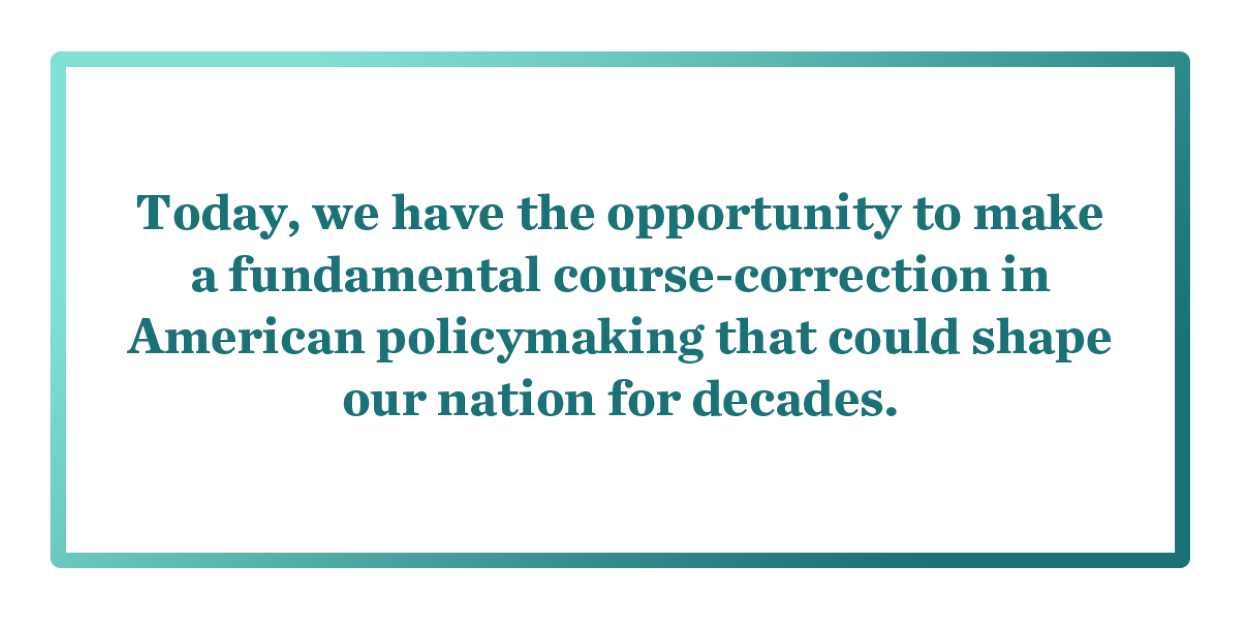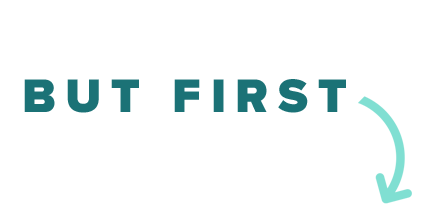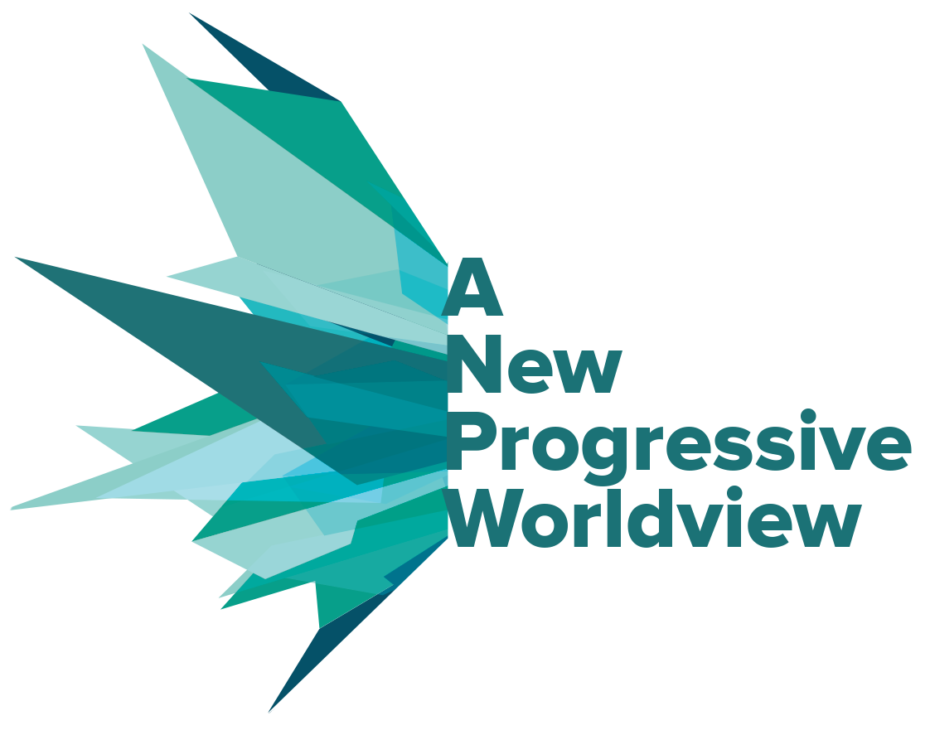America’s political landscape and economic thinking are shifting. The 2016 election—and the rise of powerful movements over the past decade—has shown us that Americans are calling for change. They want a diagnosis of our economy to help make sense of what’s gone wrong and to suggest ways to make things better. In New Rules for the 21st Century, we argue that the future of the American economy and our democracy depend on a new way of thinking about markets and a new way of thinking about government. With a renewed commitment to transforming corporations, restructuring markets, reviving democratic institutions, and reimagining the role of government, we can respond to our current political moment. Let’s restructure our economy to make both the private and public sectors better serve more Americans.
It is essential that our leaders first accurately diagnose the factors that ruptured America’s political and social fabric. Only then can they create bold policy solutions, using every tool in the toolbox, that are capable of building economic and political institutions that center the American people’s well-being. Progressives who are willing to challenge 50 years of distorted policy choices have empirics, morality, and the American people on their side.
Since the 1970s, US policies have been dictated by a distorted framework: reliance on markets and distrust of government. These policies—deregulation, tax cuts for corporations, and incentives and subsidies for a select group of market participants—alongside a shrinking government footprint, are in large part responsible for the concentration of private power, in the economy and in our politics, that ails us now.
Under a new worldview that acknowledges the existential threat of corporate power and recognizes the promise of public power, policymakers can evaluate today’s big ideas based not on price tag but on the extent to which they structurally change the way that our economy and society function. A new policy playbook based on bold rules can guide better decision-making that ultimately drives our country toward a future that can provide the economic security and agency that families—and voters—are calling for.
We must shatter the policy mold that has guided politics and policymaking for the last 50 years.
The American economy rewards those who have power—a reality rarely mentioned in conversations about economic growth and opportunity.
Bold is a big word.
It can mean revolutionary.
Ambitious.
Even radical.
Here, we explain what we mean when we used these terms.
 Concentrated or Private Power
Concentrated or Private Power
can be economic or political. When a concentrated group of wealthy people or a single firm accumulate power, they can wield influence over markets and politics in ways that rig economic outcomes in their favor and undermine democracy.
 Public Power
Public Power
means equipping the government with a set of tools to shape markets and our society. By meeting individual needs—including affordable medicine, accessible banking, and more equitable education—or by making vital investments—in expanded infrastructure, clean energy, or emerging industries—public power can serve all of us.
 Bold
Bold
ideas (and people) are capable of pushing forward structural change in our economy and democracy and can challenge entrenched power dynamics.
How did we get here?
In their daily lives, Americans are facing a host of daunting challenges.
- Shareholder-focused corporate behavior, outsized employer power, and inadequate labor law leave workers little room to advocate for themselves. Despite hard work and steady economic growth, wages are persistently low.
- Wealth inequality compounds inequality across generations and geographies. This has been particularly dire for Black Americans who have seen the already yawning Black-white wealth gap exacerbated over the last 30 years.
- We have left markets to provide the essential building blocks of a safe and secure life, making higher education, health care, and childcare increasingly unaffordable.
- Climate change is destroying the health of our planet, and it’s set to imperil the economy—and our lives.
- More than 50 years since the Civil Rights Act, gains made in reducing the racial wealth gap and dismantling discrimination and segregation—in housing, education, and the labor market—have been reversed.
- Rapid technological change in the workplace, left unchecked or implemented in ways that only benefit CEOs and shareholders, threatens workers’ livelihoods and national competitiveness.
Policy choices brought us to this moment
A Fact of Life for Americans of Color
While today’s economic inequities have reached new levels, we must also recognize that the structure of the US economy has always benefited some and excluded others. Race and gender-based discrimination and exclusion are written into our laws and built into our economy. These hidden rules of race and gender created—and continue to maintain—a baseline imbalance of wealth, power, and opportunity that plague our society.
A Calculated One-Two Punch
For nearly half of a century, corporations and the very wealthy have rigged the rules of economic policymaking to consolidate economic and political power amongst themselves with a calculated one-two punch:
1. Using government in ways that multiplied wealth for a small subset of Americans
2. Eroding public sector programs that were deemed inefficient
Armed with supply-side economic theories, private sector advocates, beginning in the 1970s, convinced policymakers to deregulate markets, lower taxes on capital gains and top incomes, and relax antitrust standards—all with the promise that the resulting economic growth would benefit all Americans. But instead of broadly shared prosperity, these policies wrought today’s entrenched inequality. Those at the top not only accrued a disproportionate share of our economy’s growth, but they in fact harmed our country’s long-term growth by building wealth in ways that did not increase productivity. Meanwhile, a concentration of economic power led to concentrated political power that allowed them to further tilt the rules in their favor.

These same leaders also argued that public spending and public provision were inherently inefficient. They championed markets as the most effective means to meet Americans’ needs and accomplish collective goals. Combining free-market rhetoric with racialized attacks on public programs, the government ratcheted down investments in certain public programs and reinvented others as subsidies to private providers.
Though skewed rule-writing in favor of the wealthy and rollbacks of public power away from the many are cast as appeals for more efficient, market-based solutions, they are most commonly packaged using core values like freedom and choice. This rhetoric helps proponents appeal to leaders and the public who share these same values. Yet, as these markets-solve-all “solutions” have played out, it’s clear that they actually forestall freedom and eliminate choice.
How “Freedom” Has Been Hijacked
This one-two punch—the alleged promise of free markets and the professed ills of government—had some true believers. But for most, it was merely an allegory that conveniently fit with the outcomes free-marketers sought to achieve: profit-seeking that was both unfettered by government restrictions and bolstered by government interventions.
What has this looked like over the past 50 years?
![]() Agricultural giants not only fought for less oversight of food safety, but they also sought big subsidies for their companies.
Agricultural giants not only fought for less oversight of food safety, but they also sought big subsidies for their companies.
![]() Drug corporations fought regulations that oversee the products that they introduce to the market, but they welcomed those that lengthen market exclusivities that allow their prices to skyrocket
Drug corporations fought regulations that oversee the products that they introduce to the market, but they welcomed those that lengthen market exclusivities that allow their prices to skyrocket
We need a policy playbook that targets the root of today’s deeply connected crises, which means that we need new rules that curb concentrated (often corporate) power and revive public power. We can—and must—reclaim government, so that it can work for all of us.
Many economists recognized that the policy shifts described above—and in greater depth in New Rules for the 21st Century—would increase inequality. They believed that this was an inevitable tradeoff—a bitter pill that we all must swallow in the name of economic growth. But now, the evidence is in: The choice between growth and shared prosperity is a fallacy. Further, it is increasingly evident that our country’s drastic inequality actually threatens the strength of our economy and democracy.
DISTORTED POLICY CHOICES BROUGHT US TO THIS MOMENT. BOLD, TRANSFORMATIVE, AND INCLUSIVE POLICY CHOICES ARE WHAT WILL REDEFINE THE AMERICAN ECONOMY.

To overcome the second Gilded Age, progressive policymakers need a one-two punch of their own: curbing the excesses of concentrated private power in our economy and political system, while also building on the strengths of government to create programs that address both the individual and collective challenges facing our nation.
If the economy rewards those with power, then we cannot build a robust and inclusive society without addressing America’s structural power imbalances.
1. Curbing Concentrated Power:
We must enact new rules that are capable of tackling concentrated wealth and power. This requires policy and regulatory changes that can reduce uncompetitive advantages and re-establish fair rules of play: enhanced antitrust enforcement, taxes on wealth and excess income, corporate governance reform, changes to labor laws, and anti-corruption reform, to name a few.
2. Reclaiming Public Power:
We must reimagine public interventions as essential to supporting security, prosperity, and inclusion in ways that markets, when left alone, never will. This means increasing the government’s role in traditional areas like health care and education. But it also means thinking about the government’s power to build a stronger country in a much more expansive way: directly providing goods and services like health care, rather than trying to facilitate market provision through subsidies to extractive providers; directing investment toward big public goals, like decarbonizing our economy, rather than relying on markets to transition quickly and justly.
New Rules for the 21st Century illustrates the crucial need to both curb corporate power and reclaim public power. Deploying the two together is necessary to move us toward a future that borrows from the best of our history, amends previous mistakes, and adapts to modern times.
This combination is what makes Roosevelt’s worldview so powerful.
What does this mean for…
 Jobs and Wages
Jobs and Wages
The first punch involves raising taxes on the top, which would reduce the incentive to enrich CEOs and shareholders and instead encourage firms to direct more resources toward productive uses, including worker pay. Increased competition from more robust antitrust enforcement would also spur new firm startups, new investment, and new demand for workers. Corporate governance reform would mean that employees and firms alike would benefit from worker representation on corporate boards.
Part of this requires empowering private sector workers—as a robust, countervailing force in the labor market. Employees would see higher wages from new (and revived) forms of collective bargaining. Rebuilding worker voice on the job, which would give employees more say over their schedules, for example, would allow them to be better family and community members at home. Another way to empower workers is to make bosses take some ownership of the costs of their own demands. If more education is required for upward career mobility, workers shouldn’t pay this price on their own.
Because some areas have been underserved by the private market over the last 50 years, a thriving market won’t solve every labor market problem—which is why we need a second punch. We can, for example, use public investments to ensure that care workers—a growing segment of today’s workforce that comprises people who work to raise the children of full-time working parents and who serve our elderly—earn incomes that reflect the value of what they do for society. Care workers, disproportionately women of color, could work for publicly run and publicly funded childcare centers, and the government would ensure that that these centers would pair high wages with opportunities for growth.
We could also explore a broader public jobs guarantee to ensure that, regardless of market failures—such as economic shocks, poorly planned trade deals, structural discrimination—every American would have the right to a job and the income and dignity associated with work. A jobs guarantee could function as a public option that sets a baseline for benefits, compensation, and equitable practices that would shape the labor market as a whole.
 Public Higher Education
Public Higher Education
The one-two punch can also help us build a better higher education system. Every student graduating from high school—regardless of family wealth, geography, or race—would know that they can go on to college. They could choose from a web of publicly funded institutions, which would range from vocational training on up to four-year colleges.
Higher education illustrates how policy wins in some areas can build a foundation for successes in others. The same first punch that helps address power imbalances in the labor market and strengthen workers’ ability to negotiate can also ensure that students are compensated upon graduation for attaining higher levels of learning.
Government can also address the particular ways that corporate power has invaded the higher education sector. For example, government can and should better regulate predatory financial products that are marketed toward college students, such as private student loans and income-sharing agreements. The providers of these financial products often exploit students’ lack of information and need for financial resources by including terms that are stacked against borrowers, including high interest rates or draconian punishments for default. Further, financial institutions have corrupted public power to facilitate this exploitation by carving out exceptions from bankruptcy protections specifically for education finance products.
With a second punch, the federal government would provide a public option that disciplines the market by providing high-quality college on an equitable basis to everyone who wants to be a student. This would require identifying a set of institutions that genuinely qualify to be designated as “public,” based on their sources of funding, policies, practices, and student populations, as well as directing funding toward these institutions. It would also mean using federal funding as a lever to ensure appropriate state contributions. Congress could eschew the deeply flawed wisdom of the past several decades that says that government should not have a hand in pricing or quality considerations. A public system must meet public goals, which means that more robust government power could set expectations for price and quality and guarantee racial and income-based inclusion.
Even a small start in this direction could be transformational. Moving toward public provisioning in minor aspects of higher education policy can eliminate extraction by private actors and reclaim public functions that have been outsourced, starting with student loan servicing. Government can—and does—perform the same tasks as private sector servicers, but it does so with greater democratic accountability and better results.


